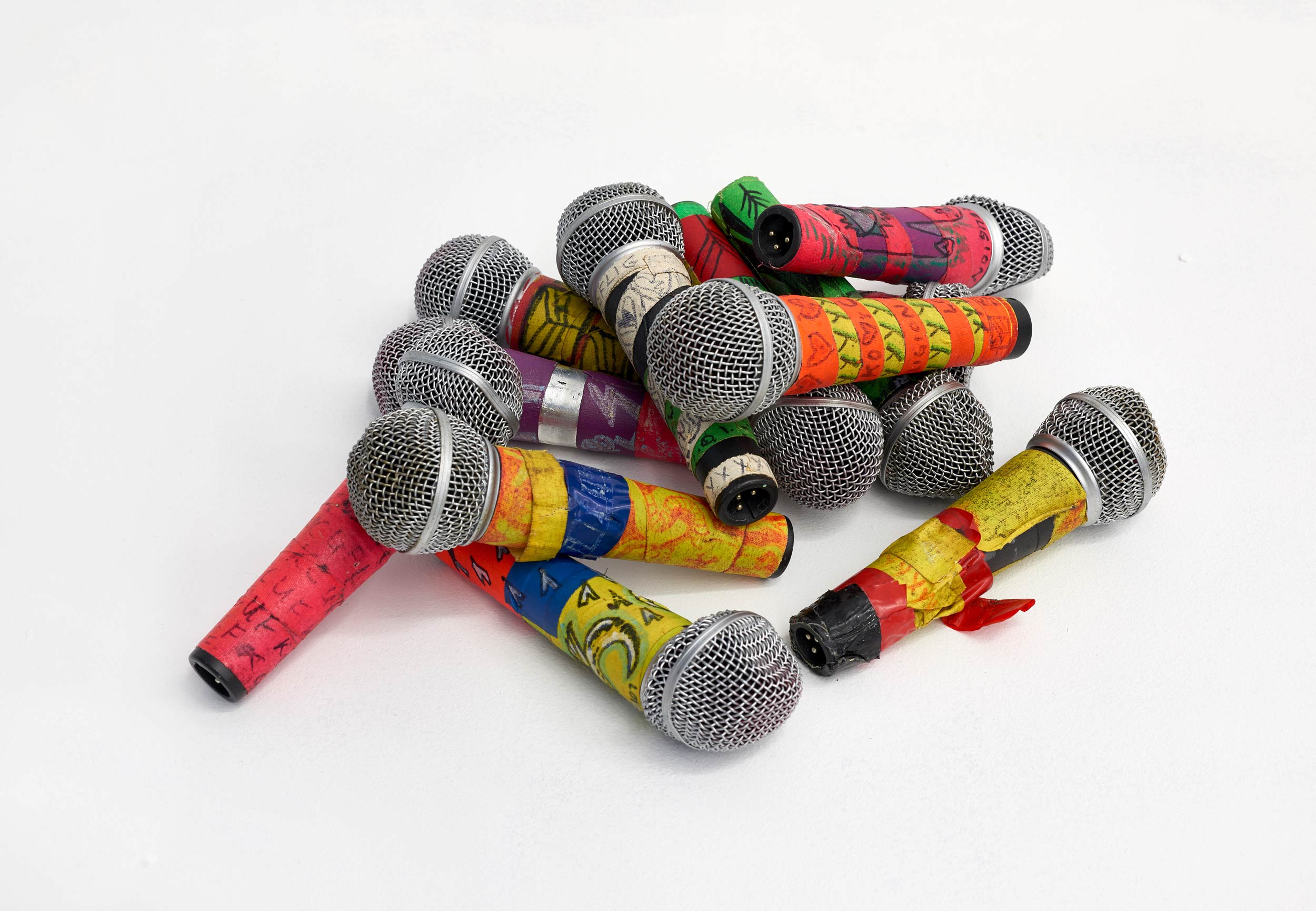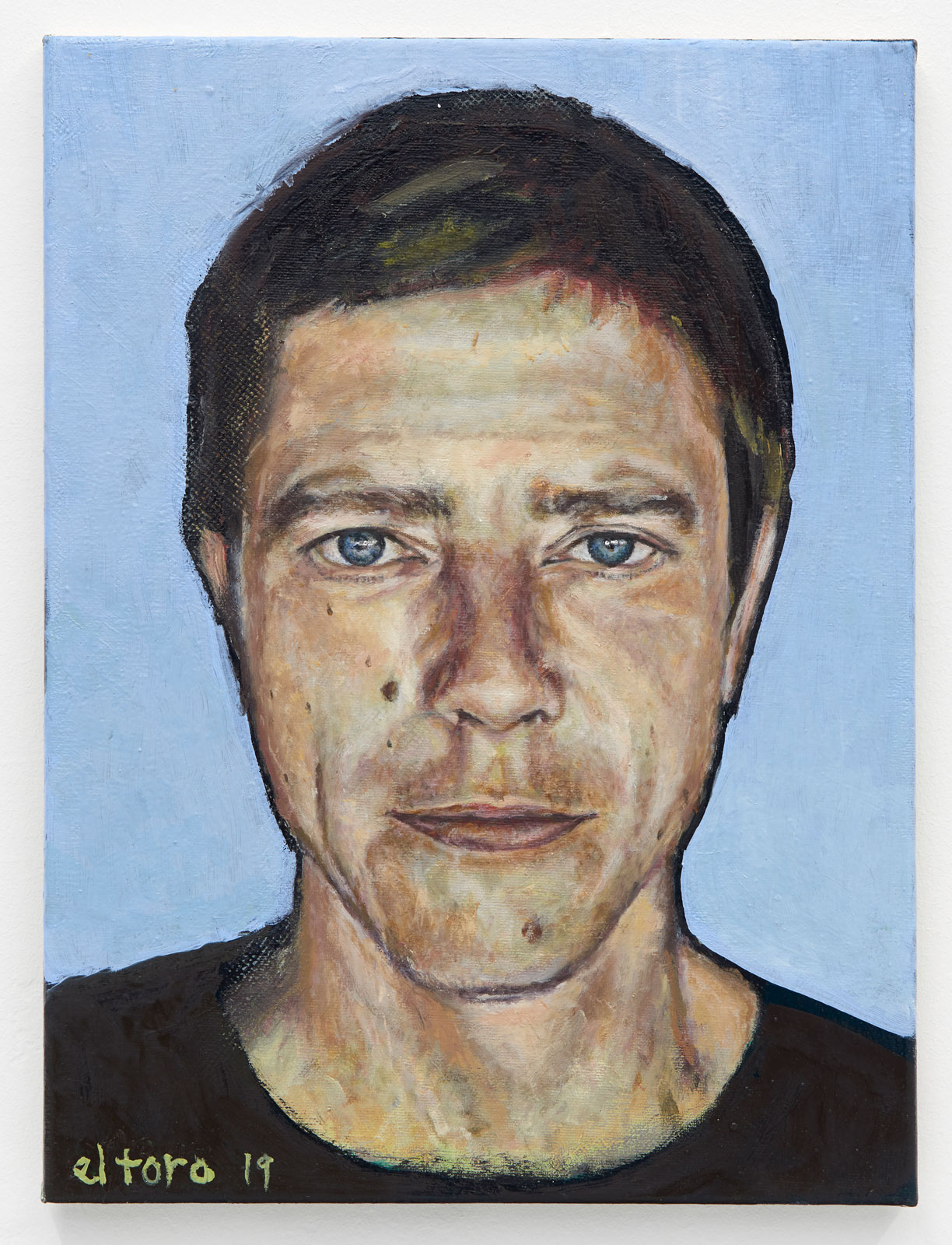The Strokes, the Yeah Yeah Yeahs, an actual bathroom. Lizzy Goodman gets the band back together on Bowery.
From Julian Casablancas and Nick Valensi of The Strokes to Allison Mosshart to Jamie Hince of The Kills, Lizzy Goodman conducted roughly 200 interviews for Meet Me in the Bathroom, an oral history tracing the resurgence of rock-and-roll that kicked off the 21st century. Through interviews with the artists who defined the era, Goodman pieces together a visceral, grimey portrait of the punk rock of post-9/11 New York—now brought to life for an exhibition at The Hole gallery on Bowery.
Meet Me in the Bathroom: The Art Show, now on view, assembles over 70 pieces of artwork by the musicians for the era, from Karen O’s drawings to paintings by Interpol’s Paul Banks. The exhibition, curated by Goodman and Hala Matar, features the photographers and visual artists who worked within the musical scene, like Ryan McGinley and Urs Fisher, who lent his work to several album covers including Yeah Yeah Yeahs’ 2009 album It’s Blitz. Housed within a gritty recreation of a bar bathroom. Rather than attempting a canonical history of the decade, Goodman and Matar instead set out to capture the “emotional sensory reality” in which these musicians lived, partied, and inadvertently created a movement.
Goodman spoke with Document in the days before the opening about getting the band(s) back together, how to conjure an electric sensory experience, and whether we can carry on rock and roll’s insurgent spirit as the Bowery is overtaken by boutiques and brunch.
Clara Malley—Was this something that you had in mind from the start—putting the exhibition together and reuniting all of these artists two years later?
Lizzy Goodman—So the impetus was, she’s gonna love this, it’s all Hala [Matar]’s fault, because she and I met at this dinner that was organized by mutual friends right after Meet Me in the Bathroom came out. And she was just like, “Hey, we should do an art show!” As soon as she said it, I started thinking that actually makes a lot of sense because the music world that I [covered] had a counterpoint in the art world, and there was a lot of interplay between those groups of visual artists who [were] sort of coming up in New York during this time and the musicians that I’ve covered. A lot of these musicians are artists, fine artists, as well.
The execution has been very exciting, and also extremely demanding. It was definitely Hala’s idea, and I give her full credit and, you know, also hold her responsible for all the sleep that I’ve lost. [Laughs]
Clara—What was it like to reconnect with a lot of these musicians you interviewed for the book and ask them to contribute work that typically they’re not as known for?
Lizzy—For me, it was like such a thrill. I mean this was really one of the primary motivators. Paul Banks doesn’t show these amazing paintings that he makes very often. I’m obsessed with Karen’s drawing work, and I want other people to see that stuff. It’s not like this show is the sole vehicle for that to happen, but I just thought the opportunity to use the frame of the book to build out the aesthetic side of what these artists do was really an exciting prospect.
Clara—There are also works by visual artists of that time, who are still making work now of course—Ryan McGinley and Doug Aitken, and so on. The show is reuniting these sort of parallel but obviously connecting artistic movements, right?
Lizzy—There’s an aesthetic about the book, that you’re trying to get at, which is this: the frame of the book was always ‘hey, there was this really weird time, that we all were fortunate enough to live through, when a bunch of kids showed up in New York chasing an idea of what their life could be like, and then made a bunch of noise, and accidentally built careers on that.’ That’s the story of punk, generally, and that’s certainly the story of this era in New York. It’s the story of a lot of the artists whose work we’re showing. So I think that’s the continuity.
This art show is about a broader and deeper sensory life; the ‘feel’ that the book was meant to capture. It’s not about what painting is hanging here, or ‘tell me more about how you made this song.’ It’s not about the intellectual idea of the thing. It’s about the feeling in your body, hopefully, when you see some of the artwork, the complete transformation of this space to replicate the energetic feel of the bar, The Hole, that we all used to hang out in. All of that is in service of an emotional sensory reality we’re trying to conjure. It’s that sense of kind of dangerous, deconstructed, electric feeling of instability that the age really was defined by.
Clara—Can you speak at all to what kinds of performances are gonna be going on?
Lizzy—When I started casting the net for who wants to play at this thing, the vibe that I had in mind was just, “let’s pretend it’s 2002, and you’re just gonna swing by with some friends to like, DJ/drink/play guitar if you feel like it. Jump on the stage if you feel like it.’ We’re not doing a hundred million performances, but there will be hopefully a sense of ‘oh! hey, that person is gonna spin for an hour’ or ‘why do I know who that is, and doesn’t he also play in this band? How did they come up together again?’ We were aware of these kinds of players and scenes, but to understand in a new way how they were breathing the same air, drinking in the same bars, feeling moved by this thing, commenting on the post-Giuliani reality in New York City. Like, we want you to walk into this space and be like, ‘I feel a little unsafe, but I’d like to go further.’ [Laughs] That’s the goal.
Clara—[Laughs] It sounds fun, honestly. It’s definitely intriguing as a premise. I guess sort as a closing question, what do you feel this era in music, and this exhibition as well, has to say about what’s going on now in New York now as it’s becoming less and less a space for young, aspiring artists, as they’re being priced out. Obviously that is also a conversation that goes along with gentrification. As artists are seeking new kinds of communities, is there anything that the rising generation can take from the way that this community came together and stayed together, navigating through similar obstacles?
Lizzy—There are a couple things come to mind, and they might be contradictory, but in a way that’s appropriate. One of the things that has come up as a theme among the musicians in this world that I know well, and then the art in this world that I’m getting to know, is this sense of an insurgent spirit. This may be just the nature of punk in any medium—to trust your gut. Karen says in the book that she knows she’s onto something in the studio, or in art in general, when it makes her feel like, ‘I might vomit, or I might start sobbing, or I might start hysterically laughing.’ Some kind of primal reaction.
What’s consistent from this era to any era of creative life is you gotta find your insurgent spirit. I always hesitate to answer a question like this too specifically because I sound like a cranky older sister. But my creative challenge is like everyone else: to find a city where I feel connected enough to a community of other artists to feel inspired, but also have space to hear my own voice and put my phone down long enough to have a fucking idea. I think that is the challenge, but the consistent philosophy is insurgency. That’s always been the thing. You’re fighting against something when you make art. You know something is supposed to exist, and it doesn’t exist, and you have to battle to make it. I think the terms of our battlefield now have just shifted. But the battle remains the same—the need to battle. So that’s one answer.
Clara—I was curious what your take would be; I was talking to these two artists who were part of the punk scene in the late ’70s, and they had a similar answer, but it is interesting to hear about all these different eras of New York life and contrasting them: what remains the same and what changes. It’s an interesting evolution.
Lizzy—It is. Well, that’s also part of the point is that every generation is just like: “The city was so much better in my day, and everything is so gross now.” And it doesn’t make those things not true, but the New York that I lived in was like a mall compared to the New York that Patti Smith first came up in. You have to find your own punk rock, wherever you are. That’s the message.
‘Meet Me In The Bathroom: The Art Show’ is curated by Lizzy Goodman and Hala Matar, presented by Vans, and organized by UTA Artist Space and The Hole. On view at The Hole gallery in New York from September 4 through 22, 2019.















